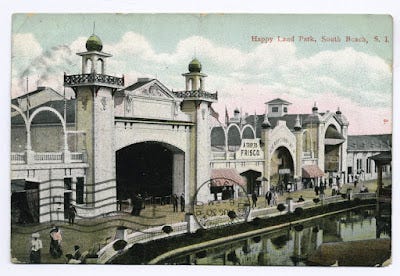Happyland Amusement Park Helped Bring a Touch of the Riviera to Staten Island

Happyland was part of a tourist attraction that made Staten Island a hot spot in the early twentieth century.
by Rich Watson
The Happyland Amusement Park was part of Staten Island’s South Beach area. Once upon a time, during the early twentieth century, “the Riviera of New York City” was a summer getaway spot that had hotels with bathing pavilions, beer gardens, casinos, and more.
Happyland occupied fifteen acres on the storefront. Its entertainment options rivaled Coney Island.
Staten Island’s South Beach
Located on SI’s east coast, south of the Verrazzano-Narrows Bridge (opened in 1964), South Beach started as a Dutch beach colony in the seventeenth century. By the latter part of the nineteenth century, developers had built it up into a seaside retreat.
Among its attractions included a seventeen-hundred-foot boardwalk and a roller coaster created by LaMarcus Thompson, the father of the modern roller coaster (it only lasted four years).
Two fires swept through the area, one in 1896, the other in 1902. Happyland was built as an enclosed area when it opened four years later.
Happyland and its attractions
Happyland had some decent rides for the early twentieth century: a carousel, an airship ride, a mini-railroad (also designed by Thompson), a circle swing, a log flume-like ride and a revolving tower 190 feet tall.
There was a vaudeville theater. There was a roller rink, bandstand, shooting galleries, penny arcades and a Japanese garden. Aviator Lincoln Beachey flew between Happyland and Manhattan for ten days in 1907. A wooden roller coaster was built called the Roller Boller Coaster.
Nearby Midland Beach, to the south, was also a popular tourist destination with similar attractions.
In 1919 Happyland suffered another fire, one that claimed a life. Five years later Midland Beach also suffered fires. Both areas were rebuilt, but in 1929 fires plagued the area again.
Boardwalk
In the 1930s, during Franklin D. Roosevelt’s regime as president, the Works Progress Administration provided the funding for a two-and-a-half-mile boardwalk connecting South Beach with New Dorp. Happyland was razed.
Construction was completed in 1937. The boardwalk was named for Roosevelt himself. It was redeveloped in the fifties, adding parking, bathhouses, and recreational facilities.
The city also added Seaside Boulevard, which ran parallel to the boardwalk. Later, in 1976, it was renamed for Father Vincent Capodanno, a Catholic chaplain who died in the Vietnam War.
The South Beach-FDR Boardwalk was renovated in the nineties, and again after Hurricane Sandy hit in 2012.
Happyland may be long gone, but the South Beach area remains a popular destination.
@byrichwatson
—————————
Do you know someone who went to Happyland?


